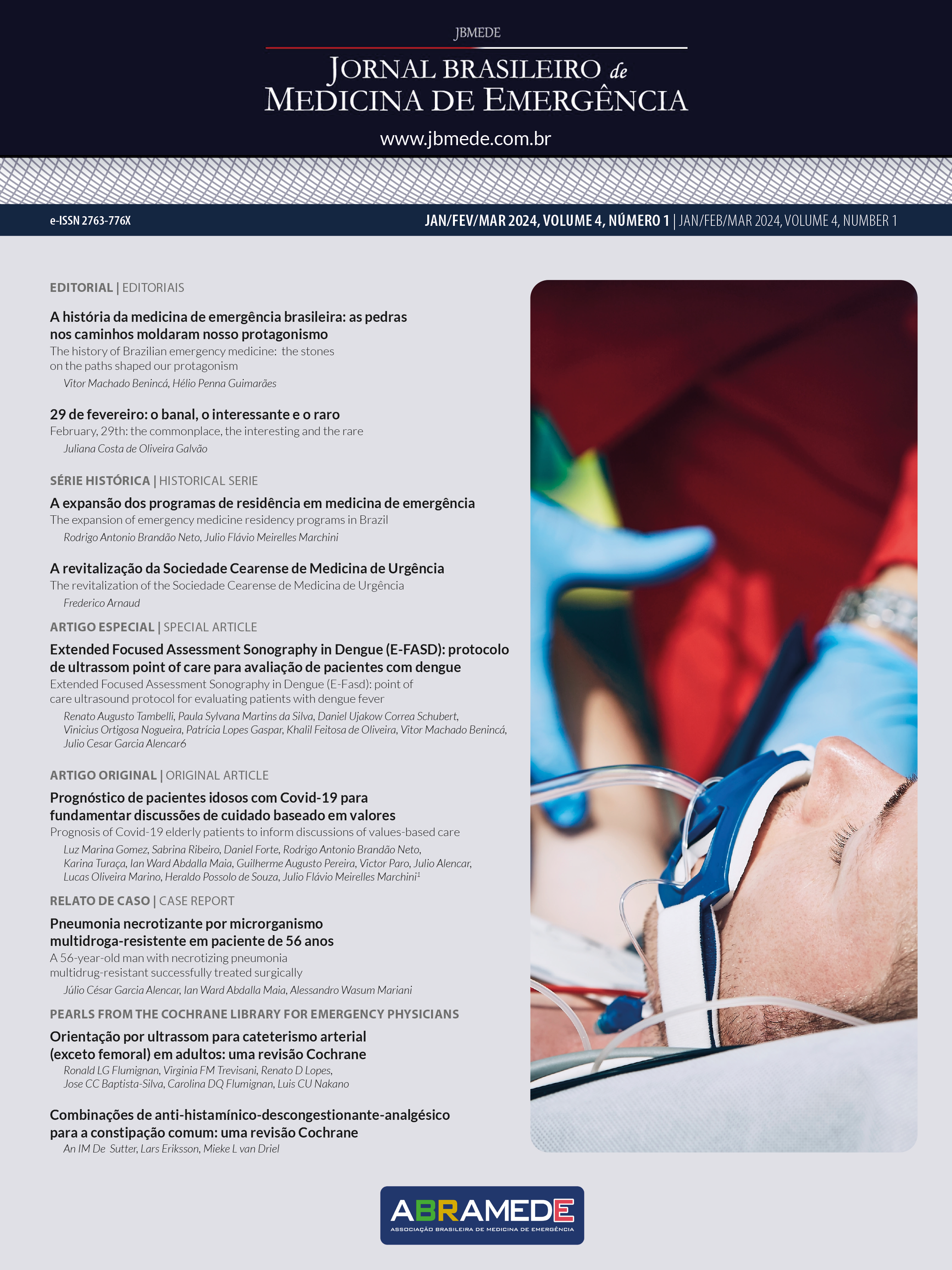Prognosis of Covid-19 elderly patients to inform discussions of values-based care
Main Article Content
Abstract
Objective: To investigate the prognosis of elderly patients in a large elderly cohort with Covid-19. We evaluated additional predictors of mortality beyond age in these elderly patients. Methods: The study was a retrospective analysis of data from a major Covid-19 referral center in São Paulo, Brazil. We included all patients aged 75 or above and were admitted to the hospital with Covid-19 from March 2020 to May 2021. We used regression to identify independent factors for mortality.
Statistical analyses were carried out using R. Results: About 49% of these patients were intubated. Intubated patients had an 80% mortality rate compared to a 22,7% for non-intubated patients. For intubated male sex patients, higher Simplified
Acute Physiology Score 3, higher heart rate and an unwell apparent state of health contributed to a worse prognosis. For the non-intubated patients, a lower peripheral oxygen saturation at presentation, higher heart rate, older, dementia and a history of mialgia at presentation as well as an unwell apparent state of health contributed to a worse prognosis. Conclusion: Elderly Covid-19 patients have a poor prognosis when intubated and this should be considered at the outset. Therefore, intubation in this population should probably not be considered standard practice, especially if for the individual patient under consideration, their functional independence is a priority over extending life span.
Article Details

This work is licensed under a Creative Commons Attribution 4.0 International License.
References
Kellett J, Rasool S, McLoughlin B. Prediction of mortality 1 year
after hospital admission. QJM. 2012;105(9):847-53.
Brandão Neto RA, Marchini JF, Marino LO, Alencar JCG, Lazar
Neto F, Ribeiro S, et al.; Emergencia USP Covid group. Mortality
and other outcomes of patients with coronavirus disease
pneumonia admitted to the emergency department: A prospective
observational Brazilian study. PLoS One. 2021;16(1):e0244532.
Erratum in: PLoS One. 2021;16(3):e0248327.
Beynon T, Gomes B, Murtagh FE, Glucksman E, Parfitt A, Burman
R, et al. How common are palliative care needs among older
people who die in the emergency department? Emerg Med J.
;28(6):491-5.
Teunissen SC, de Haes HC, Voest EE, de Graeff A. Does age matter
in palliative care? Crit Rev Oncol Hematol. 2006;60(2):152-8.
Ouchi K, Jambaulikar GD, Hohmann S, George NR, Aaronson
EL, Sudore R, et al. Prognosis after emergency department
intubation to inform shared decision-making. J Am Geriatr Soc.
;66(7):1377-81.
von Elm E, Altman DG, Egger M, Pocock SJ, Gøtzsche PC,
Vandenbroucke JP; STROBE Initiative. The Strengthening the
Reporting of Observational Studies in Epidemiology (STROBE)
statement: guidelines for reporting observational studies. J Clin
Epidemiol. 2008;61(4):344-9.
Guidet B, de Lange DW, Boumendil A, Leaver S, Watson X,
Boulanger C, et al.; VIP2 study group. The contribution of frailty,
cognition, activity of daily life and comorbidities on outcome in
acutely admitted patients over 80 years in European ICUs: the VIP2
study. Intensive Care Med. 2020;46(1):57-69.
Fiorentino M, Pentakota SR, Mosenthal AC, Glass NE. The Palliative
Performance Scale predicts mortality in hospitalized patients with
Covid-19. Palliat Med. 2020;34(9):1228-34.
Beglinger B, Rohacek M, Ackermann S, Hertwig R, Karakoumis-
Ilsemann J, Boutellier S, et al. Physician’s first clinical impression
of emergency department patients with nonspecific complaints
is associated with morbidity and mortality. Medicine (Baltimore).
;94(7):e374.
Ouchi K, Lawton AJ, Bowman J, Bernacki R, George N. Managing
code status conversations for seriously ill older adults in respiratory
failure. Ann Emerg Med. 2020;76(6):751-6.
Hewitt J, Carter B, Vilches-Moraga A, Quinn TJ, Braude P, Verduri
A, et al.; COPE Study Collaborators. The effect of frailty on survival
in patients with Covid-19 (COPE): a multicentre, European,
observational cohort study. Lancet Public Health. 2020;5(8):e444-51.

